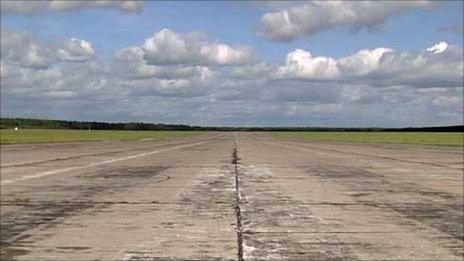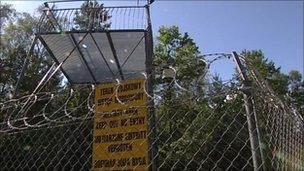What happened in Europe's secret CIA prisons?
- Published

Szymany airport, Poland, where CIA flights arrived
The CIA used a secret prison in Poland to detain and torture its most important 9/11 suspect, a former top human rights official alleges in a new BBC documentary.
On 7 March 2003 a CIA Gulfstream Jet landed at a remote airstrip in north-eastern Poland. Human rights officials and campaigners are convinced that Khalid Sheikh Mohammed, one of the most senior al-Qaeda suspects, was on board.
American agents took him to a secret facility where, he says, he was tortured before being eventually transferred to Guantanamo Bay.
The secret transfer of CIA prisoners is said to have taken place in both Poland and Lithuania - a region where, only a generation ago, people were subject to arbitrary detention and torture at the hands of Communist secret police.
Now, seven years on, the full story of Poland's secret detention site is emerging.
Dick Marty, the Council of Europe's former Rapporteur on Torture, told the BBC: "If I use the judicial standard of proof - and I used to be a magistrate - then I say 'Yes, Mohammed was in Poland. Yes, he was tortured.'"
Thomas Hammarberg, the Council of Europe's Commissioner on Human Rights, said he now believed detainees had been subjected to "intense torture" and called for prosecutions.
Mastermind's arrival
In the aftermath of 9/11, Khalid Sheikh Mohammed was one of America's most wanted, accused of masterminding the attacks on New York and Washington. He was finally seized in Pakistan in March 2003 and flown around the world.

Khalid Sheikh Mohammed: Captured and moved around the world
The CIA's Inspector General, the internal watchdog, has said he was subjected to "183 applications of the waterboard" in a single month, one of the so-called "enhanced interrogation techniques" then used by the CIA.
At the heart of the counter-terrorism programme launched in the wake of 9/11, believed to be codenamed Greystone, was a decision to use secret detention sites to hold what it termed "high-value detainees".
Dick Marty's reports have described them as a "global spider's web" of clandestine sites, external, linked by secret rendition flights.
The BBC has seen logs which confirm that executive jets leased by the CIA landed at the isolated Szymany airstrip in north-east Poland between December 2002 and September 2003.
"We were given information about the flights from the central command of the Border Guards," Mariola Przewlocka, who was then the airport's facilities manager, told the BBC.
"They asked for as few airport staff as possible to be there at the time of landing. There were high-ranking officers present during the departure of the planes and there were never any customs officers."
In an interview with the International Committee of the Red Cross, external, Khalid Sheikh Mohammed laid out his evidence for believing he was taken to Poland
Mr Mohammed said he was driven a short distance from the airfield to the place where he was detained. He said there was snow on the ground, people were speaking an Eastern European language and he was offered a bottle of water with a Polish e-mail address on its label.
Maximum security
According to Mariola Przewlocka, the planes would always be met by vehicles with licence plates linked to Stare Kiejkuty, a nearby intelligence training base.

Secret facility: Stare Kiejkuty base at the centre of investigations
We found the base after a drive through the local woods. Cameras were placed on all corners and razor wire enclosed a large area by the shores of a lake.
A United Nations report, published in February 2010, alleges that eight terrorist suspects were held at Stare Kiejkuty.
All of them were "high-value detainees" whom the CIA believed had information about future terrorist operations.
The pressure was intense to force Khalid Sheikh Mohammed to spill his secrets. He told the International Committee of the Red Cross that on the worst day of his interrogation his head was "banged against the wall so hard that it started to bleed".
"Finally I was taken for a session of water boarding. The torture on that day was finally stopped by the intervention of the doctor," he said.
Speaking last year at the American Enterprise Institute, external, the former Vice-President Dick Cheney defended the way the suspect was handled.
"American personnel were not there to commence an elaborate legal proceeding, but to extract information from him before al-Qaeda could strike again and kill more of our people."
But according to the CIA Inspector General's own findings, things went wrong.
One of the detainees was Abd Al-Rahim Al-Nashiri, accused of leading the 2000 attack on the USS Cole which killed 17 American sailors. The watchdog found that an interrogator cocked an unloaded handgun against Al-Nashiri's head. He added that another agent probably used a power drill to frighten the naked and hooded detainee on the same day. Mr al-Nashiri's lawyers have demanded that Poland investigates.
From a drab block on the edge of the city, the Warsaw Prosecutor's office has spent two years investigating the allegations. They're saying little about what they have learned - other than their work has months to go.
But it isn't just Poland facing accusations.
Destination Lithuania
Soon after the CIA stopped using Stare Kiejkuty, planes began arriving in neighbouring Lithuania.
"I was approached by the head of the State Security Department in the summer of 2003," Rolandas Paksas, Lithuania's president at the time, told the BBC. "He asked for my permission to allow our foreign partner to bring people in secret to Lithuania and hold them here."
Mr Paksas says he refused. Soon afterwards, he was impeached on corruption charges.
A Lithuanian parliamentary inquiry, external found that following Paksas' refusal, a detention facility was built that was equipped to hold detainees. This was after the country had joined the European Union.
That facility can be found nestled in the woods on the outskirts of Vilnius, close to some run-down apartments. It is now used as an intelligence training base. Local people have told the BBC that they saw American contractors take over the former horse-riding stables.
The parliamentary inquiry went on to confirm that CIA planes had landed in Lithuania - but it said there was no evidence detainees had ever been taken to the facility.
Arvydas Anusauskas, chairman of the parliamentary inquiry, said: "Two or three people at the State Security Department (SSD) hid information and misused their power.
"They allowed this to happen on Lithuanian territory without telling our political leaders. This is a very serious matter."
Just as in Poland, a prosecutor in Vilnius is investigating. Earlier this month, lawyers for another Guantanmo Bay detainee, Abu Zubaydah, claimed their client had been held in the country.
But Avydas Pocius, the former director-general of the SSD, says it was "impossible" that the CIA had moved prisoners through the country.
"It's impossible that these flights were used to take passengers," he told the BBC. "Customs officers had full rights of access to the aircraft. But sometimes colleagues did ask us to help them to deliver diplomatic post. They wanted us to help them get to the airport faster."
Mr Pocius told the BBC that political leaders were aware of the secret facility.
Henrikas Mickevicius, of Lithuania's Human Rights Monitoring Institute, says the country needs answers.
"I feel betrayed," he said. "We fought hard for what we achieved 20 years ago - freedom, democracy, the rule of law and protection of human rights. We paid a high price for this and then we sold it cheaply."
In a statement to the BBC the CIA said "The programme is over. This agency does not discuss publicly where detention facilities may or may not have been."
